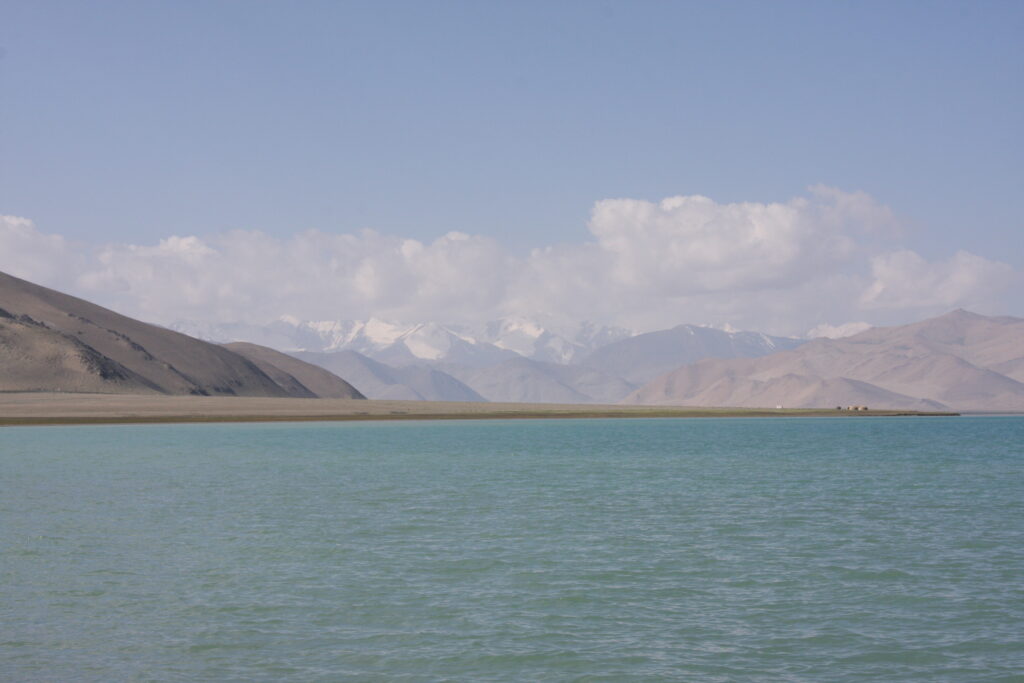Mass balance of glacier №139 in the Eastern Pamir’s lake Karakul Basin
H. Kabutov a*, A.Kayumov a, T. Saks b, H. Navruzshoev a, F. Vosidov a, N. Nekkadamova a, A. Khalimov.
a Glacier Studies Center of the Academy of Sciences of the Republic of Tajikistan State Scientific Institution (SSI), 33 Rudaki Ave., Dushanbe 734025, Tajikistan;
b University of Fribourg, Department of Earth Sciences, Fribourg, Switzerland
E-mail: kabutov.khusrav@gmail.com
A.Kayumov: abdkaumov@mail.ru , T. Saks: Tomassakss@gmail.com, H. Navruzshoev: nhd140704@gmail.com, F. Vosidov: firdavs.vosidov@mail.ru, N. Nekkadamova: nuriyashka94@mail.ru, A. Khalimov: halimov.ardamehr@mail.ru.
https://doi.org/10.29258/CAJWR/2022-R1.v8-2/128-140.engResearch article

Abstract
Mountain glaciers, including the poorly examined ones in the Lake Karakul Basin, are considered the most vulnerable part of the cryosphere directly reacting to the changing climatic conditions. The most recent aerial imaging and single field surveys of the Lake Karakul Basin glaciation were carried out as late as in 1953. The investigation of the basin’s glaciers thus is of high scientific relevance, including in terms of glaciology and climatology. The article describes the calculations of the surface mass balance (SMB) of Glacier No.139 in the Lake Karakul Basin allowing, based on the findings, to assess the degree of climate change impact on the glaciation in the target zone, as well as the potential changes in the state of glaciers in the future. During 2018-2019, the mass balance of Glacier No.139, located in the basin’s southwestern section, amounted to -0.26 mwe. The data obtained from the Karakul Weather Station allowed establishing that the climate in the target watershed is harshly cold with little snow in winter and mild summer, and the bulk of precipitation occurring in the warm season. Due to the fact that in the past and until recently no glacier mass observations were conducted in the target zone, the research findings can serve as initial data to expand the scientific and applied knowledge, as well as contribute to enhancing the accuracy of glacier dynamics modeling in the area.
Available in English
Download the article (eng)For citation: Kabutov, H., Kayumov, A., Saks, T., Navruzshoev, H., Vosidov, F., Nekkadamova, N., Khalimov, A. (2022). Balans massy lednika № 139 bassejna ozera Karakul’ Vostochnogo Pamira [Mass balance of glacier No. 139 in the basin of Lake Karakul in the Eastern Pamirs]. Central Asian Journal of Water Research, 8(2), 70–84. https://doi.org/10.29258/CAJWR/2022-R1.v8-2/128-140.eng
References
Atlas, L.E., Varnakova, G.M., Rototayeva, O.V. (1975). USSR Surface Water Resources. USSR Glacier Catalogue [Resursy poverhnostnyh vod SSSR. Katalog lednikov SSSR], vol. 14 (Central Asia), issue 3 (Amu Darya), sec. 17 (rivers of the Karakul Basin). Moscow: Hydrometeoizdat [in Russian]
Dolgova, E.A., Matskovsky, V.V, Solomina, O.N., Rototaeva, O.V, Nosenko, G.A, Khmelevskaya, I.F. (2013). Reconstruction of the Garabashi Glacier mass balance (1800–2005) based on dendrochronological data [Rekonstrukcija balansa massy lednika Garabashi (1800–2005 gg.) po dendrohronologicheskim dannym]. Ice and Snow 53(1), pp. 34–42 https://doi.org/ 10.15356/2076- 6734-2013-1-34-42. [in Russian]
Elsasser, H., Bürki, R. (2002). Climate change as a threat to tourism in the Alps. Climate Research, 20(3), pp. 253–257 doi:10.3354/cr020253
Global Glacier Change Bulletin No. 2 (2014–2015) (2017). Eds. M. Zemp, S.U. Nussbaumer, I. Gärtner- Roer, J., Huber, H. Machguth, F. Paul, M. Hoelzle. Zurich: World Glacier Monitoring Service doi: 10.5904/wgms-fog-2017-10
Hagg, W., Braun, L.N., Uvarov, V.N., Makarevich, K.G. (2004). A comparison of three methods of mass-balance determination in the Tuyuksu glacier region, Tien Shan, Central Asia. Journal of Glaciology, 50(171), pp. 505–510 DOI:10.3189/172756504781829783
Hoelzle, M., Barandun, M., Bolch, T., Fiddes, J., Gafurov, A., Mussione, V., Saks, T. and Shahgedanova, M. (2020). The status and role of the alpine cryosphere in Central Asia. In The Aral Sea Basin: Water for Sustainable Development in Central Asia.Eds. Xenarios, S., Schmidt-Vogt, D., Qadir, M., Janusz-Pawletta, B. and Abdullayev, I., Ch. 8, pp. 100–121 DOI:10.4324/9780429436475-8
Jackson, M., Tenzin, S. and Tashi, T. (2014). Glacier Mass Balance measurements in Bhutan. 16(c), 16069
Kenzhebayev, R., Barandun, M., Kronenberg, M., Yaning Chen, Usubaliyev, R., Hoelzle, M. (2017). Mass balance observations and reconstruction for Batysh Sook Glacier, Tien Shan, from 2004 to 2016. Cold Regions Science and Technology, 135, pp. 76-89 available at: https://doi.org/10.1016/ j.coldregions.2016.12.007
Kronenberg, M. (2016). From point measurements to glacier wide mass balance (available at: https://wgms.ch/downloads/CATCOS16_06_Kronenberg_point-to-glacierwide-mass-balance. pdf), accessed April 10, 2020
Kronenberg, M., Barandun, M., Hoelzle, M., Huss, M., Farinotti, D., Azisov, E., Usubaliyev, R., Gafurov, A., Petrakov, D. and Kääb, A. (2016). Mass-balance reconstruction for Glacier No. 354, Tien
Shan, from 2003 to 2014. Annals of Glaciology, 57(71), pp. 92–102 available at: https://doi. org/10.3189/ 2016AoG71A032
Mirzokhonova S.O. (2019). Impact of climate change on the hydrological regime of the Pyanj river basin [Vlijanie izmenenija klimata na gidrologicheskij rezhim bassejna reki Pjandzh]. PhD thesis (available at: https://www.imoge. tj/kitobho/Monographiya_Mirzokhonova-S.O.pdf.), accessed October 5, 2022 [in Russian]
Oerlemans, J.H. (2005). Extracting a Climate Signal from 169 Glacier Records. Science, 308(5722), pp. 675–677 DOI:10.1126/science.1107046
Ostrem, G. and Brugman, M. (1991). Glacier Mass-Balance Measurements: A Manual for Field and Office Work. NHRI Science Report 4. Saskatoon, Canada
Panov V.D. (2001). Evolution of modern glaciation of the Caucasus [Evoljucija sovremennogo oledenenija Kavkaza], PhD in Geography thesis abstract. Rostov-on-Don, p. 58 [in Russian]
Popovnin, V.V. and Pylayeva, T.V. (2015). Avalanche feeding of the Djankuat Glacier. Ice and Snow, 55(2), pp. 21–32 available at: https://doi.org/ 10.15356/2076-6734-2015-2-21-32
Radić, V., Hock, R. (2011). Regionally differentiated contribution of mountain glaciers and ice caps to future sea-level rise. Nature Geoscience, 4, pp. 91–94 doi:10.1038/ngeo1052
USSR Scientific and Applied Climate Reference Book [Nauchno-prikladnoj spravochnik po klimatu SSSR] (1988). 3rd Series, Perennial Data, parts 1-6, issue 31, Tajik SSR [in Russian]
Weather and Climate Website. Climate data, climate archives (available at: http://www.pogodaiklimat. ru/history.php), accessed August 5, 2021 [in Russian]
World Shapefiles (available at: https://tapiquen-sig.jimdo.com/english-version/free-downloads/ world/), accessed Oct 30, 2019
Eastern Pamir, glacier mass balance, glaciology, Karakul Lake Basin, mountain glaciers